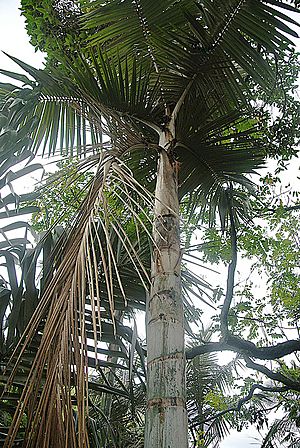Pumbo wax palm facts for kids
Quick facts for kids Pumbo wax palm |
|
|---|---|
 |
|
| Conservation status | |
| Scientific classification | |
| Genus: |
Ceroxylon
|
| Species: |
echinulatum
|
The Pumbo wax palm (scientific name: Ceroxylon echinulatum) is a special type of flowering plant. It belongs to the Arecaceae family, which is the palm family. This tall, beautiful palm tree is only found in two countries: Ecuador and Peru.
It grows naturally in specific places. These are moist montane forests in the Andes mountains. A montane forest is a forest that grows on the side of a mountain. Sadly, the Pumbo wax palm is in danger. Its natural home is shrinking because of habitat loss. This means its forest environment is being destroyed.
Contents
What is the Pumbo Wax Palm?
The Pumbo wax palm is a type of tree known for its tall, straight trunk. It can grow very high, reaching impressive heights in the mountains. Like other palms, it has large, fan-like leaves at the top. The "wax" in its name comes from a waxy substance on its trunk. This wax helps protect the tree.
How Do Palms Grow?
Palms are unique plants. They start as small seeds and grow into tall trees. They have a single stem, or trunk, that usually doesn't branch out. New leaves grow from the top, and older leaves eventually fall off. This leaves scars on the trunk, which can tell you how old the palm is.
Where Does the Pumbo Wax Palm Live?
This special palm tree lives in the Andes mountain range. The Andes stretch along the western side of South America. The Pumbo wax palm specifically grows in parts of Ecuador and Peru.
Its Mountain Home
The Pumbo wax palm prefers a certain kind of environment. It likes "subtropical or tropical moist montane forests." This means it lives in warm, wet forests on mountainsides. These forests often have a lot of rain and mist. The high altitude and specific climate are perfect for this palm.
Why is the Pumbo Wax Palm in Danger?
The Pumbo wax palm is listed as a "Vulnerable" species. This means it faces a high risk of becoming extinct in the wild. The biggest threat to this palm is habitat loss.
Understanding Habitat Loss
Habitat loss happens when the natural places where plants and animals live are destroyed. For the Pumbo wax palm, this means its mountain forests are being cut down. People might clear land for farming, building, or logging. When the forest is gone, the palm trees lose their home. They also lose the resources they need to survive, like water and nutrients.
Protecting These Palms
Protecting the Pumbo wax palm is important. It helps keep the balance of nature in the Andes forests. Conservation efforts aim to stop habitat loss. This includes creating protected areas and educating people about the importance of these unique trees. By understanding the threats, we can help save the Pumbo wax palm for the future.


